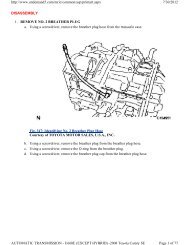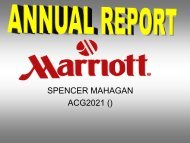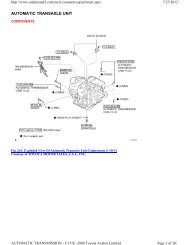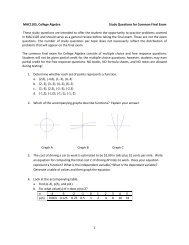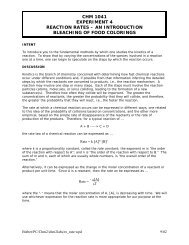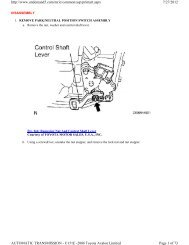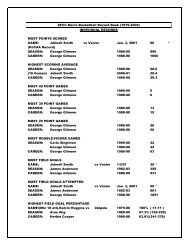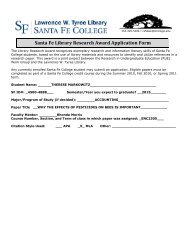Apple
Apple
Apple
Create successful ePaper yourself
Turn your PDF publications into a flip-book with our unique Google optimized e-Paper software.
<strong>Apple</strong> inc. has done really well for its self in<br />
the past couple of years. The company is very<br />
profitable and it shows through the increase<br />
in net income and the increase of stock sales.<br />
<strong>Apple</strong>’s stock is at a very high price now<br />
proving that many investors trust that <strong>Apple</strong><br />
can sustain profitability. <strong>Apple</strong>’s success<br />
could be credited to its iproducts. The<br />
increased popularity of the iPod, iPhone, and<br />
iPad have rocketed sales.<br />
<strong>Apple</strong> inc. Annual Report
Introduction<br />
<strong>Apple</strong>’s founder and chief<br />
executive officer is Steve Jobs.<br />
His office is located at 1 Infinite<br />
loop Cupertino, California 95014.<br />
<strong>Apple</strong>’s ending date of the last<br />
fiscal year was September 25,<br />
2010. <strong>Apple</strong>s primary products<br />
are iPhones, iPods, computers<br />
and computer software. Their<br />
main geographic area of activity<br />
is in the Americas, Europe,<br />
Japan, and Asia.
Audit Report<br />
<strong>Apple</strong>’s independent auditor is Ernst and young<br />
LLP. They said that the financial statements are<br />
presented fairly in all the material with respect<br />
to the consolidated financial position of <strong>Apple</strong>.<br />
The results of its operations and cash flows are<br />
in conformity with the generally accepted<br />
accounting principles of the U.S.
Stock Market<br />
Information<br />
The most recent price of the<br />
company’s stock is $372.5<br />
The twelve month trading<br />
range of the company’s stock<br />
is from $281.82 to $422.86<br />
Dividend per share are 0<br />
Date of the above information<br />
October 5, 2011<br />
In my opinion about <strong>Apple</strong>’s<br />
stock I would have to say sell<br />
because its stock is really high<br />
right now and it will not last<br />
for long especially since the<br />
death of Steve Jobs.
<strong>Apple</strong>s future plan is to develop operating systems that are easy to use, well<br />
integrated, with a well industrialized design. <strong>Apple</strong> continues to stay ahead of<br />
competition with new innovations and products that capture our interests.<br />
With the introduction of the new iPad many other companies have followed in<br />
their footsteps to try and enter the tablet market. The iPhone another one of<br />
<strong>Apple</strong>s biggest success is one of the best selling smart phones in the U.S. and<br />
apple will continue to produce iPhones that are truly innovative.<br />
http://www.apple.com/ipad/<br />
http://www.apple.com/iphone/#
•Format most like a multistep format.<br />
•Gross profit, income from operations, and net<br />
income all increased but net income stood out<br />
the most because it had a staggering increase of<br />
about 70%.<br />
Gross Profit Income<br />
From<br />
Operations<br />
2009 $17,222 $12,066 $8,235<br />
Net Income<br />
2010 $25,684 $18,540 $14,013
Assets= Liabilities+ Stockholder’<br />
s Equity<br />
2009 $47,501 $15,861 $31,640<br />
2010 $75,183 $27,395 $47,791<br />
•All of <strong>Apple</strong>’s balance sheet accounts have<br />
increased but assets showed the biggest increase.
•Cash flows from operations have been more than<br />
net income for the past two years.<br />
•The company growing through investing<br />
activities.<br />
•The company’s primary source of financing is<br />
stock sales.<br />
•Overall, has cash increased over the past two<br />
years by almost doubling.
•Revenue Recognition- Net sales is derived primarily<br />
from revenues through the sale of software,<br />
hardware, digital content, peripherals, and service<br />
and support contracts. <strong>Apple</strong> recognizes revenue in<br />
accordance with industry specific software<br />
accounting guidance.<br />
•Cash- All highly liquid investments with maturities<br />
of there months or less are counted as cash<br />
equivalents.
Accounting Policies<br />
• Short-term investments- Marketable securities with<br />
maturities of less than 12 months are classified as<br />
short- term while marketable securities with maturities<br />
of more than 12 months are classified as long term.<br />
• Inventories- are computed using the first in first out<br />
method. The companies inventories consist of<br />
components and finished goods.<br />
• Property and Equipment- Depreciation is computed by<br />
straight line method over the useful lives of the asset.
Topics of the Notes to Financial<br />
Statements.<br />
1)Summary of Significant Accounting Policies<br />
2)Financial Instruments<br />
3)Fair Value Measurements<br />
4)Consolidated Financial Statements Details<br />
5)Goodwill and other Intangible Assets<br />
6)Income Taxes<br />
7)Shareholder’s Equity and Stock-Based Compensation<br />
8)Commitment and Contingencies<br />
9)Segment information and Geographic Data<br />
10)Selected Quarterly Financial Information (Unaudited)
Financial Analysis<br />
Liquidity Ratios 2009 2010<br />
Working Capitol $14,286 $20,049<br />
Current Ratio 2.7 1.5<br />
Receivables Turnover<br />
Average Day’s Sales<br />
uncollected<br />
16.1 11.07<br />
7.98 11.97<br />
Inventory Turnover 48.2 62.3<br />
Average Day’s Inventory<br />
on Hand<br />
7.62 5.98
Financial Analysis<br />
Liquidity Ratios<br />
Working capital increased because total assets increased.<br />
Current ratio has decreased because current liabilities have<br />
almost doubled in the year.<br />
Receivables turnover has decreased because net sales increased<br />
substantially while accounts receivable only increased by a little<br />
bit.<br />
Average day’s sales uncollected has increased because receivables<br />
turnover had decreased.<br />
Inventory turnover has increased because inventory for 2010 has<br />
increased.<br />
Average day’s inventory on hand has decreased because<br />
inventory turnover has increased showing that <strong>Apple</strong> is selling<br />
more inventory and is having less inventory on hand.
Financial Analysis<br />
Profitability Ratios<br />
2009 2010<br />
Profit Margin 19.2% 21.5%<br />
Asset Turnover .96 1.1<br />
Return on Assets 25.5% 23.8%<br />
Return on Equity 20.7% 35.3%
Financial Analysis<br />
Profitability Ratios<br />
Profit margin rose in 2010 because sales<br />
increased.<br />
Asset turnover increased because assets<br />
were increased.<br />
Return on assets decrease because net<br />
income increased.<br />
Return on equity has increased because<br />
more stockholders have invested in <strong>Apple</strong>.
Financial Analysis<br />
Solvency Ratio<br />
For the past two years debt to equity has increased because<br />
liabilities has increased substantially.<br />
2009 2010<br />
Debt to equity 0.50 0.57
Financial Analysis<br />
Market Strength Ratios<br />
Price/earnings per<br />
share<br />
2009 2010<br />
20.08 18.65<br />
Dividends Yield 0 0<br />
<strong>Apple</strong> stock price/ earnings per share decreased over the<br />
year because the price of the stock rose greatly within<br />
that year. The company did not pay out dividends<br />
because they anticipated that for the foreseeable future<br />
they will retain any earnings and use it for operations<br />
of its business.





